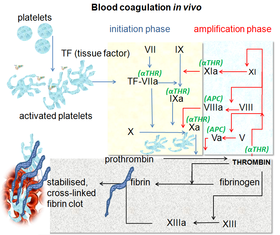Thrombin time
| Thrombin time | |
|---|---|
 Blood coagulation pathways in vivo showing the central role played by thrombin | |
| Other names | TCT |
| MeSH | D013918 |
The thrombin time (TT), also known as the thrombin clotting time (TCT), is a
The thrombin time compares the rate of clot formation to that of a sample of normal pooled plasma. Thrombin is added to the samples of plasma. If the time it takes for the plasma to clot is prolonged, a quantitative (fibrinogen deficiency) or qualitative (dysfunctional fibrinogen) defect is present.[3] In blood samples containing heparin, a substance derived from snake venom called batroxobin[4] (formerly reptilase) is used instead of thrombin. Batroxobin has a similar action to thrombin but unlike thrombin it is not inhibited by heparin.[1]
Normal values for thrombin time are 12 to 14 seconds.[5] If batroxobin is used, the time should be between 15 and 20 seconds. Thrombin time can be prolonged by heparin, fibrin degradation products, and fibrinogen deficiency or abnormality.
Test procedure
After separating the plasma from the whole blood by centrifugation, bovine thrombin is added to the sample of plasma. Clot formation is detected optically or mechanically by a coagulation instrument. The time between the addition of the thrombin and the clot formation is recorded as the thrombin clotting time.[citation needed]
Specimen requirements
Whole blood is taken with either
Reference ranges
The
Limitations
Blood samples that are more than eight hours old can give inaccurate results when tested.[8]
See also
- Coagulation cascade
- Partial thromboplastin time (PTT), or activated partial thromboplastin time (aPTT or APTT)
- Prothrombin time (PT)
References
- ^ ISBN 978-1-4051-8460-1.
- S2CID 14313728.
- ISBN 978-1-4051-8050-4.
- ^ Batroxobin factsheet
- ^ ISBN 978-0-632-05153-3.
- PMID 1904284.
- ^ "Screening Tests in Haemostasis: The Prothrombin Time [PT]". practical-haemostasis.com.
- S2CID 23594097.
